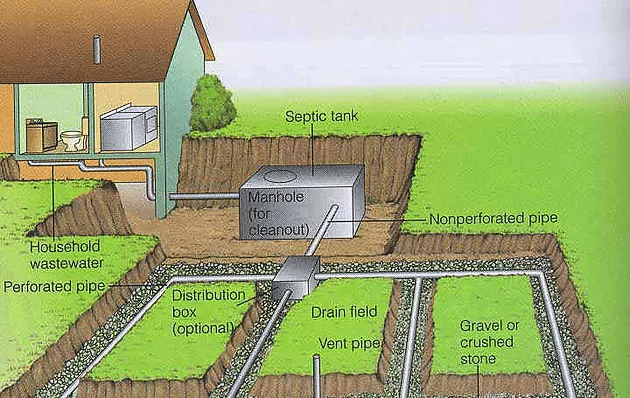We are often asked about septic systems and septic inspections.
In this blog you will find
- Types of Septic Systems
- How Septic Systems Work
- Septic Maintenance
- Septic Inspection
- Limitations
Septic systems were invented by the French in the 1860s. By the 1880s, the two-stage septic tank systems were installed in the United States. Today,nearly 20% or 1/5 of all households have a septic system. The number of households using septic systems has been steadily increasing. Unfortunately, many homeowners install and forget the septic system and are often surprised that their system requires maintenance or pumping.
There are basically 3 types of septic systems:
- Septic tank with no disbursement of liquids to a leach field.
- Conventional septic tank with disbursement of liquids to a leach field.
- Aerobic septic system which pumps disbursement of liquids to a leach field.
HOW SEPTIC SYSTEMS WORK
Some of the older systems will contain 1 or more tanks plus a grease trap. Grease traps are usually located outside the house close to the kitchen window.
Septic tanks contain anaerobic bacteria which breaks down the solids thus extending the time before the tanks need to be pumped. In the contemporary aerobic systems, bleach or chlorine tablets are added throughout the year to treat the liquids prior to being pumped to the leach field.
In the diagram above, this septic tank contains two chambers. Solids and liquids enter the first chamber through the inlet. Solids sink to the bottom and liquids rise to the top. When there is enough liquids, they will enter the second chamber through an opening in the chamber baffle which separates the two tanks. The liquids in the second chamber will rise until they are disbursed through the outlet to the leach field.
In older septic system, this same type concept is used. Instead of one tank with two chambers, two or more tanks exist. Solids and liquids enter the first tank. Liquids flow to the second tank where they are disbursed to the leach field.
The size of the septic system and how many tanks are needed depend upon the size of the house and how many persons will be occupying the house.
Determining whether the system is sized properly for the house is beyond the scope of the typical inspection.
The above diagram illustrates the installation of the leach field. The piping contains weep holes for the liquids to disburse to the soil. The pipes are buried under ground.
Some aerobic systems use sprinkler heads to disburse the liquids. Pipes will run from the septic system to the sprinkler heads in the leach field.
SEPTIC MAINTENANCE
Septic maintenance consists of perform the following:
- Inspecting and pumping the tanks for solids.
- Adding chlorine of bleach to the system (for aerobic systems only).
- Adding anaerobic bacteria to the septic system.
- Repair or replacement of sprinkler heads (aerobic systems only).
- Repair of septic pump (aerobic systems only).
- Quarterly inspections (reports required to the county).
All septic systems require occasional pumping. How often septic systems have to pumped vary depending upon the size of the tanks and usage. Only period inspections can determine whether the septic system is ready to be pumped.
Almost all localities require quarterly inspections of the septic system by a certified septic inspector. For that reason, septic pumping companies offer maintenance programs to do just that.
If there is not a regulatory requirement, the homeowner can easily determine if the tanks need to be pumped by removing the service port plug and examining the interior. In older systems, there will be a concrete plug located somewhere in the tank lid. Some plugs have handles. Others require a pry bar to remove the plug. On aerobic systems, the green tank lids are above the ground and can be removed with a screwdriver. Some of these use special tips which can be purchased at a hardware store.
Quarterly inspections of the septic system are an essential part of septic maintenance.
Typically, tanks need to be pumped when the solids are 6 inches or less from the top of the chamber baffle opening. (3-5 years in most cases)
For aerobic systems, chlorine tablets or bleach must be added throughout the year to help treat the liquids before the liquids disburse to the leach field. If the homeowner has pets, this is very important as the pets or wildlife can drink this water and become very sick.
Adding chlorine tablets or bleach throughout the year is important to keep the disbursement water safe to animals.
Adding anaerobic bacteria to the septic system is seldomly done and there is debate about how helpful they really are. Best time to add would be after the tanks have been pumped. This can be purchased from a septic supply company.
For more information on anaerobic bacteria, click here.
Sprinkler heads used on aerobic systems are often damaged by lawn mowers. Replacement heads can be purchased from a septic supply company or possibly from a local hardware store. A septic installation company can also be used to repair or replace sprinkler heads.
Septic pumps are used to pump the liquids to the leach field and to the sprinkler heads. Occasionally, these pumps stop working. Contact a septic installation company for repair.
SEPTIC INSPECTIONS
A septic inspection is a visual inspection and consist of the following:
- Location of tanks and grease trap.
- Removal of service plugs for conventional system or removal of tank lids for aerobic systems.
- Determine if tanks need to be pumped.
- Examination of inlet and outlet pipes inside the tank to the extent they can be examined.
- Examination of septic pump condition and operation.
- Testing pump alarm.
- Testing of sprinkler heads if equipped with testing functionality.
- Location of leach field (if possible).
- Perform plumbing test to ensure water from the house is entering septic system and blockages do not exist.
Septic inspections do not include the following:
- Determination that the septic system is sized properly for the house and number of occupants.
- Determination of cracks in tank walls because liquids and solids obstruct examination.
- Determination of leach field functionality and efficiency.
- Determination of condition of leach field pipes.
- Site scope examination through the piping to examine the condition of the pipes from the house to the septic system.
- Determining the size of the tanks.
LIMITATIONS
Older systems and vacant homes can hide plumbing issues during a home or septic inspection which will appear only after house is occupied and plumbing and septic systems are under regular use.




